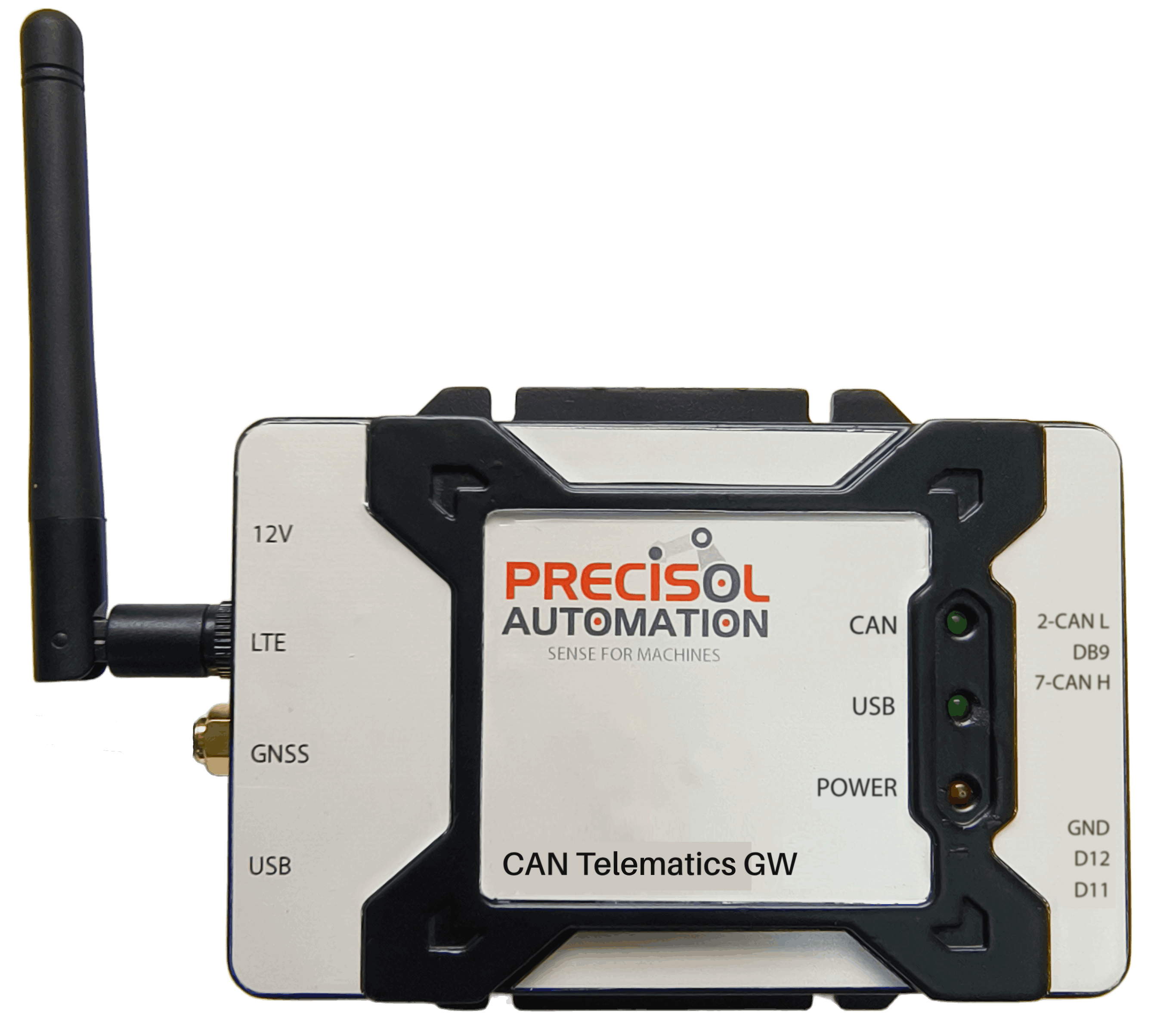Optimizing Waste Management with the Precisol Automation CAN Telematics Gateway
Waste management is a cornerstone of modern urban infrastructure, yet it is an industry fraught with challenges. From navigating congested city streets and optimizing collection routes to managing high fuel consumption and the wear and tear on specialized vehicles, waste collection companies operate on razor-thin margins. Traditional methods of fleet management—relying on manual logs, driver reports, and reactive maintenance—often fall short, leading to inefficiencies, increased operational costs, and a larger environmental footprint. The key to transforming this sector lies in leveraging real-time vehicle data. By integrating a sophisticated telematics solution, waste management companies can move from a reactive model to a proactive, data-driven strategy that boosts efficiency, reduces costs, and enhances sustainability.
Challenges in Waste Management
Waste management fleets face a unique set of obstacles that distinguish them from other transportation industries. These challenges are a direct result of their operational model, which involves frequent stops, heavy loads, and complex urban routes.
- Operational Inefficiency:Manual route planning is often suboptimal, leading to wasted time and fuel from inefficient paths, missed pickups, and unnecessary idling.
- High Maintenance Costs:Waste collection trucks are subject to extreme wear and tear. Constant stopping and starting, heavy lifting, and exposure to harsh environments put immense strain on transmissions, brakes, and hydraulic systems, leading to frequent and costly unscheduled repairs.
- Fuel Consumption:Due to their size, weight, and the nature of their work, waste management vehicles are notoriously fuel-intensive. Without accurate monitoring, fuel is often one of the largest and least-controlled operational expenses.
- Limited Visibility:Fleet managers often have a limited view of what is happening in the field. They lack real-time data on driver behavior, vehicle health, and route status, making it difficult to address issues as they arise or hold drivers accountable for safe and efficient operation.
- Reactive Maintenance:Without real-time diagnostic information, maintenance is typically performed reactively, only after a vehicle has already broken down. This leads to costly tow services, extended downtime, and disruptions to collection schedules.
What is a Telematics Gateway and How It Works
A telematics gateway is an advanced hardware device that serves as a central nervous system for a vehicle, collecting vital operational data and transmitting it to a central management platform. The Precisol Automation CAN Telematics Gateway is a prime example of this technology. It functions as a powerful data logger and cellular transmitter, bridging the gap between a vehicle’s internal systems and a cloud-based fleet management dashboard.
The gateway's connection to the vehicle is straightforward. Modern waste trucks, like all modern vehicles, contain a Controller Area Network (CAN) bus, a network of wires that allows the vehicle's various electronic control units (ECUs) to communicate. The telematics gateway connects directly to this CAN bus, typically through the vehicle’s OBD-II port, a standard diagnostic interface. Once connected, the gateway performs three critical functions:
- Data Collection: It continuously listens to the data flowing across the CAN bus. This raw, technical data includes thousands of signals related to engine performance, fuel consumption, odometer readings, and diagnostic trouble codes (DTCs).
- Data Translation:The raw data packets are meaningless without context. The gateway uses a pre-programmed DBC (Database CAN) file, which acts as a dictionary to translate these codes into meaningful, real-world parameters. This process turns a hexadecimal string into an easily understandable value like “Engine RPM: 1,500” or “Fuel Level: 75%.”
- Cloud Transmission:This meaningful data is then securely transmitted over a cellular network (4G/2G) to a central cloud server. Precisol’s gateway sends this information to the PreciCloud dashboard, where it is stored, analyzed, and presented in an accessible format for fleet managers.
This entire process happens in real-time, providing an uninterrupted stream of data that forms the foundation for intelligent fleet management.

How It Improves Waste Management Efficiency
Integrating the Precisol gateway transforms the entire waste management operation by providing a powerful new layer of intelligence.
- Optimized Routing and Fuel Efficiency: The gateway’s integrated GPS and live data stream allow fleet managers to monitor a vehicle’s route in real-time. By analyzing historical route data alongside fuel consumption, companies can identify inefficient paths and refine their collection schedules. This leads to reduced mileage, less idling, and significant savings on fuel costs.
- Predictive Maintenance: Instead of waiting for a vehicle to break down, managers can use the gateway's real-time diagnostic data to predict potential failures. The system can be configured to send automated alerts for common issues like excessive engine temperatures, a drop in hydraulic pressure, or a spike in engine load. This allows maintenance teams to schedule repairs proactively during off-hours, preventing costly emergency breakdowns and maximizing vehicle uptime.
- Enhanced Driver Behavior Monitoring: The gateway can track key driver performance metrics, such as hard braking, rapid acceleration, and excessive idling. Fleet managers can use this data to provide targeted coaching and training, promoting safer and more fuel-efficient driving habits.
- Accurate and Transparent Data: The automated data collection eliminates the need for manual driver logs, which are often inaccurate or incomplete. The gateway provides an objective, tamper-proof record of every aspect of the vehicle's operation, improving accountability and providing a clear audit trail.
Benefits of a Telematics Gateway for Waste Management
The shift to a data-driven model with the Precisol CAN Telematics Gateway delivers a range of tangible benefits that directly impact the bottom line and operational quality.

- Reduced Operational Costs:By optimizing routes, improving fuel efficiency, and moving to predictive maintenance, companies can slash their single largest expenses—fuel and maintenance. This financial saving is immediate and substantial.
- Increased Fleet Uptime: Proactive maintenance and the prevention of unexpected breakdowns mean more vehicles are on the road and ready for service, ensuring collection schedules are met consistently and reliably.
- Improved Safety and Compliance:Monitoring driver behavior promotes a culture of safety, reducing the risk of accidents. The accurate data also helps companies meet stringent regulatory and environmental compliance standards.
- Enhanced Decision-Making:Fleet managers can leverage the detailed data to make more informed decisions about everything from route planning and vehicle replacement cycles to staffing and resource allocation.
- Environmental Impact: Optimized routes and reduced fuel consumption directly contribute to a smaller carbon footprint, aligning a company's operations with modern environmental sustainability goals.
By providing a clear and comprehensive view into the heart of every vehicle, a CAN telematics gateway empowers waste management companies to achieve new levels of efficiency, reliability, and profitability.


